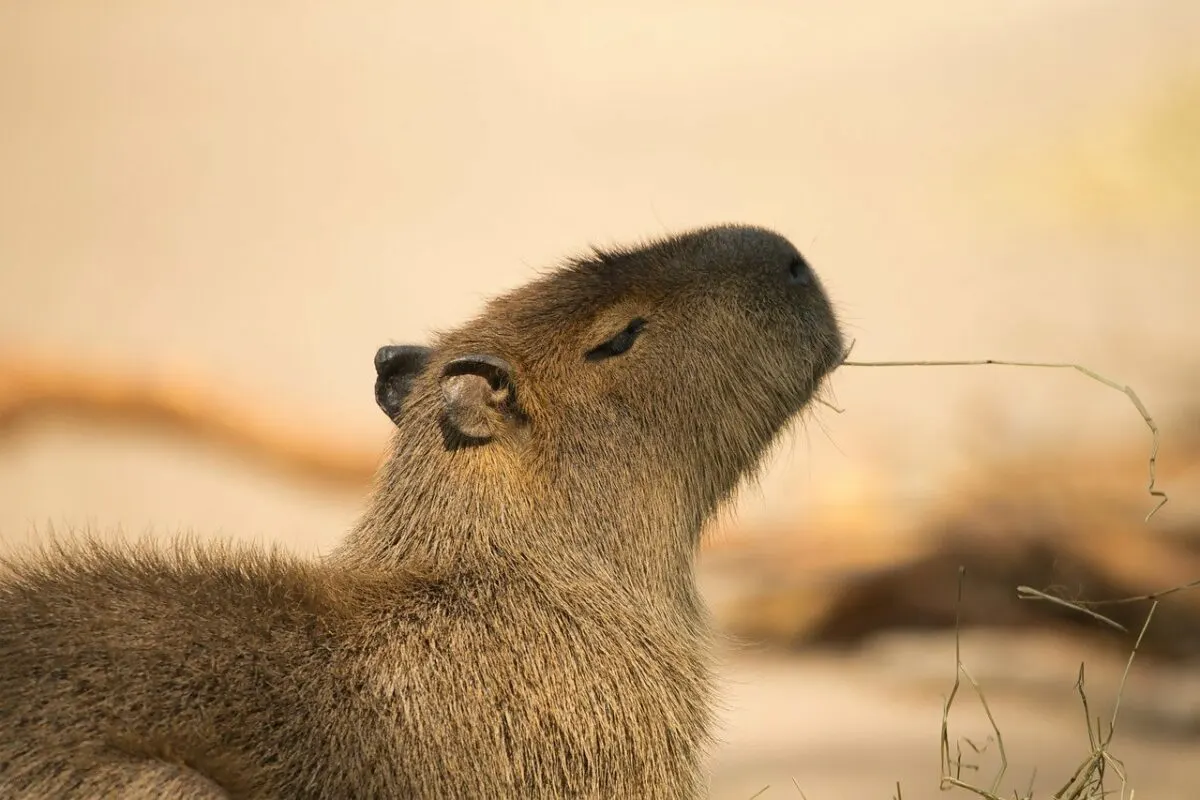Are you tired of the same old pets like cats and dogs? Do you want a furry friend that’s unique, interesting, and downright adorable? Look no further than the capybara – the world’s largest rodent and the hottest new pet trend!
But can capybaras really make good pets? Aren’t they wild animals that belong in the jungle? Don’t worry; we’ve got you covered.
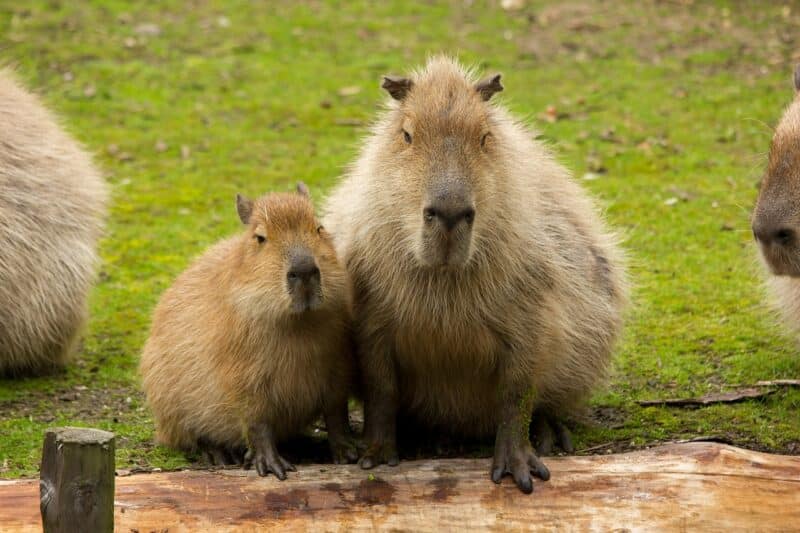
In this article, we’ll answer all your burning questions about capybaras as pets and show you why these fascinating creatures might be the perfect addition to your household.
So sit tight, keep your hair on, and let’s dive into the world of capybara!
Want to jump ahead? Click below
Description of Capybaras

What is a Capybara?
Have you ever seen an animal that looks like a cross between a beaver and a guinea pig? That’s the capybara! These amazing creatures are the world’s largest rodent, weighing up to 140 pounds and growing to be over 4 feet long.
They have short, sturdy legs and webbed feet that make them great swimmers. Capybaras have a round body covered in short, brownish fur that keeps them warm in their natural habitat. These adorable creatures have a distinctive face, with a blunt snout, big ears, and eyes that are set high on their head.
What is the Natural Habitat and Behavior of Capybaras?
Capybaras are fascinating animals that are native to South America. They are found in countries like Brazil, Peru, and Venezuela, where they can often be seen near bodies of water like rivers, lakes, and swamps.
These semi-aquatic creatures have a unique set of physical and behavioral characteristics that make them well-suited to life in these environments.
- Social Nature
One of the most interesting things about capybaras is their social nature. These animals are pack animals and are known for their friendly and docile personalities.
They can often be found hanging out in groups of up to 20 individuals, enjoying each other’s company and barking up a storm. Capybaras use a variety of vocalizations to communicate with each other, including whistles, grunts, and clicks.
Capybaras are also very social with other animals. They are often seen hanging out with birds, such as ducks and herons, who help keep them clean by eating parasites off their skin.
Capybaras are also known to befriend other animals like dogs and horses, making them a great addition to any animal-loving household.
- Semi-Aquatic Animals
As semi-aquatic animals, capybaras are very comfortable in and around water. They have webbed feet that make them excellent swimmers, and they can hold their breath for up to five minutes while underwater.
Capybaras are also known to spend a lot of their time lounging in the water, using it to cool off and socialize with their friends.
Capybaras are herbivores, which means they feed on plants. They eat a variety of vegetation, including grasses, aquatic plants, and fruits.
In the wild, they are often seen grazing on the banks of rivers and lakes. Because they need to eat a lot of vegetation to maintain their large bodies, capybaras spend a significant amount of their time eating.
Behavioral Characteristics
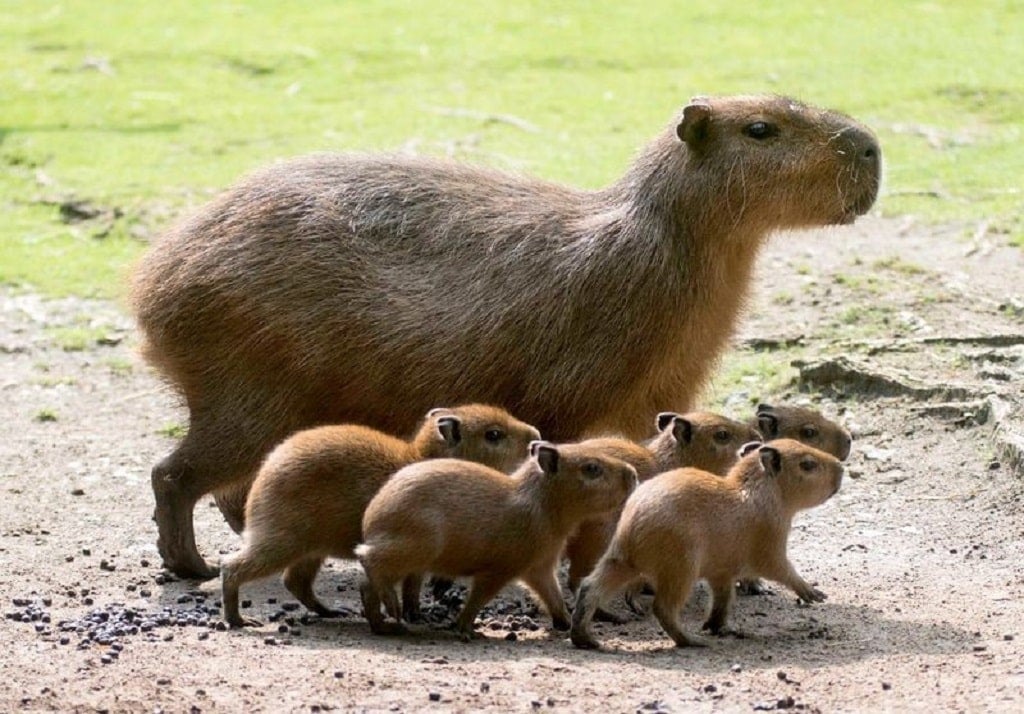
Capybaras have a number of interesting behavioral characteristics that set them apart from other animals. For example, they are known for their grooming behavior, in which they use their front teeth to groom themselves and each other.
This grooming behavior not only helps keep their fur clean but also helps them maintain their social bonds.
Let us delve deeper into their behavioral traits and explore what makes them so interesting.
Grooming Behavior
Capybaras are social animals that love being around others of their kind. They are known for their grooming behavior, which is an essential aspect of their social life.
They use their front teeth to groom themselves and each other, which helps keep their fur clean and well-maintained. This grooming behavior is not only for hygiene but also helps them to build and maintain social bonds.
Intelligence and Adaptability
Capybaras are intelligent creatures that have a keen sense of their surroundings. They are very good at recognizing and avoiding danger, and they have a keen sense of smell that helps them detect predators.
They are also capable of learning a variety of tasks and behaviors. In addition, capybaras are highly adaptable animals that can adjust to different environments. They can thrive in a variety of habitats, from tropical rainforests to grasslands.
Reproductive Behavior
Capybaras are polygamous animals, which means that males mate with multiple females. Female capybaras give birth to litters of up to eight young, called pups.
These young are born fully developed and can swim and run shortly after birth. Capybara mothers are very protective of their young and will fiercely defend them against predators.
How do Capybaras avoid predators?
Capybaras have a variety of behaviors that help them avoid predators. For example, they are very good at swimming and can use bodies of water as an escape route from predators.
They can hold their breath for up to five minutes, which helps them stay underwater for extended periods. Capybaras also have a unique way of staying alert when they’re sleeping.
They sleep with their eyes open and their ears alert, which allows them to detect danger quickly and avoid being caught off guard.
Can Capybaras be Kept as Pets?
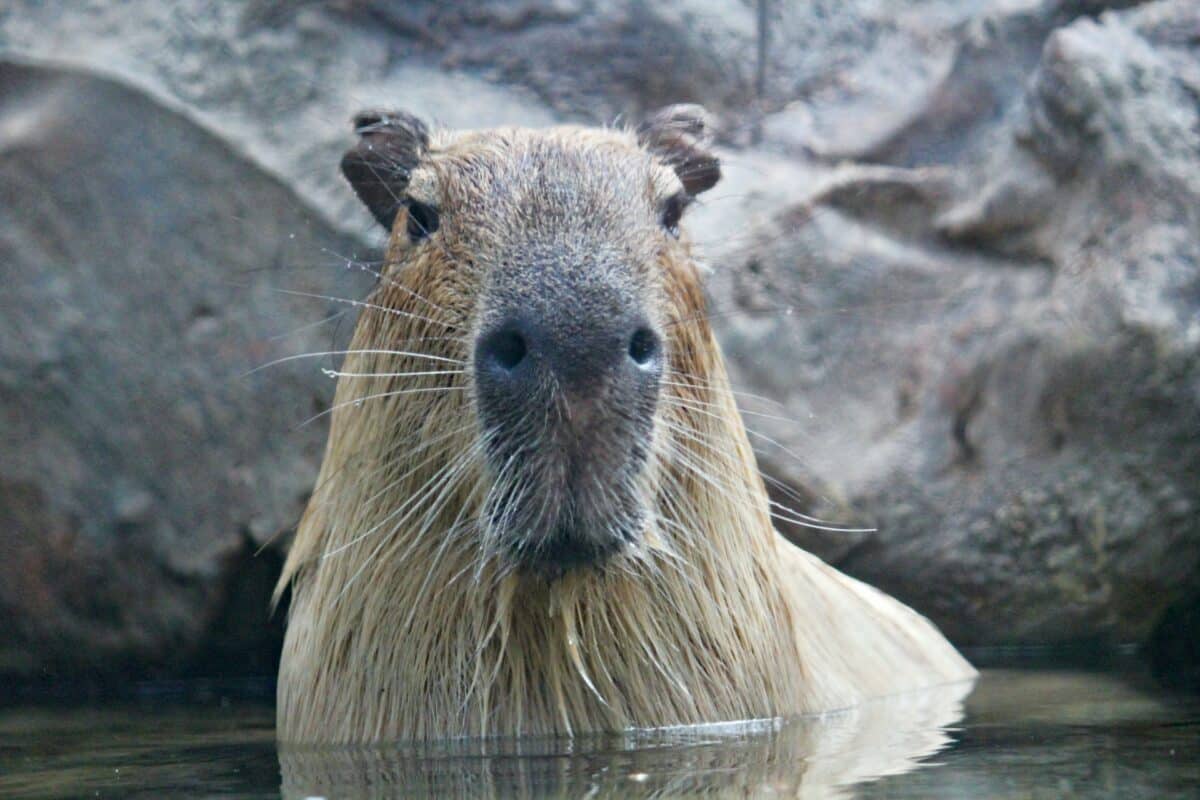
Capybaras have become increasingly popular as pets in recent years, thanks to their friendly and docile personalities.
However, before considering getting one as a pet, it is important to understand the legal status of capybaras as pets, the challenges and responsibilities of owning one, and the best practices for capybara care.
What is the Legal Status of Capybaras as Pets: can I keep capybaras as pets in the U.S.?

In many parts of the world, capybaras are classified as exotic pets, which means that they are not allowed to be kept as pets without a permit or license. It is important to check the local laws and regulations regarding capybara ownership before considering getting one as a pet.
In the United States, capybaras are legal to own in some states, but not in others. For example, they are legal in Texas, but illegal in California. It is important to do thorough research and consult with local authorities before getting a capybara as a pet.
Best Practices for Capybara Care
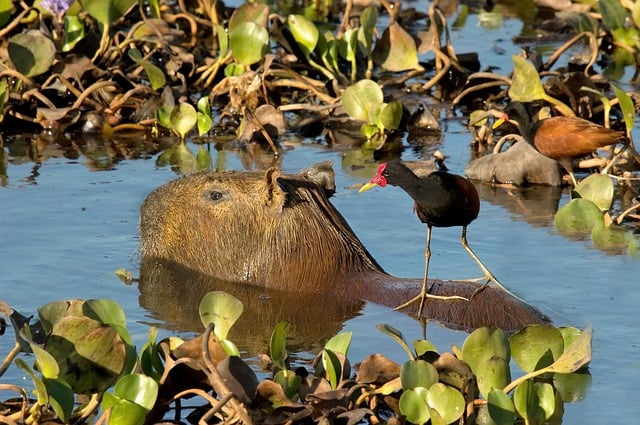
If you are considering getting a capybara as a pet, it is important to follow best practices for capybara care to ensure their health and wellbeing. They include:
- Living Space
Capybaras require a large living space with access to water. A backyard with a swimming pool or a large pond is ideal. They also require a sheltered area to protect them from the sun and extreme temperatures.
- Diet
A balanced diet of hay, grass, and vegetables is essential for capybara health. They should be fed twice a day and given fresh water daily.
- Grooming
Capybaras require regular grooming to keep their fur clean and prevent skin irritation. This can be done by brushing their fur with a soft brush and bathing them in lukewarm water.
- Exercise and Socialization
Capybaras require daily exercise and socialization with their owners or other capybaras. They love to play and explore, so providing them with toys and opportunities to explore their environment is important for their mental and physical health.
- Veterinary Care
Capybaras require regular veterinary checkups to monitor their health and detect any potential health issues early on. It is important to find a veterinarian with experience in treating exotic animals.
Capybaras As Therapy Animals
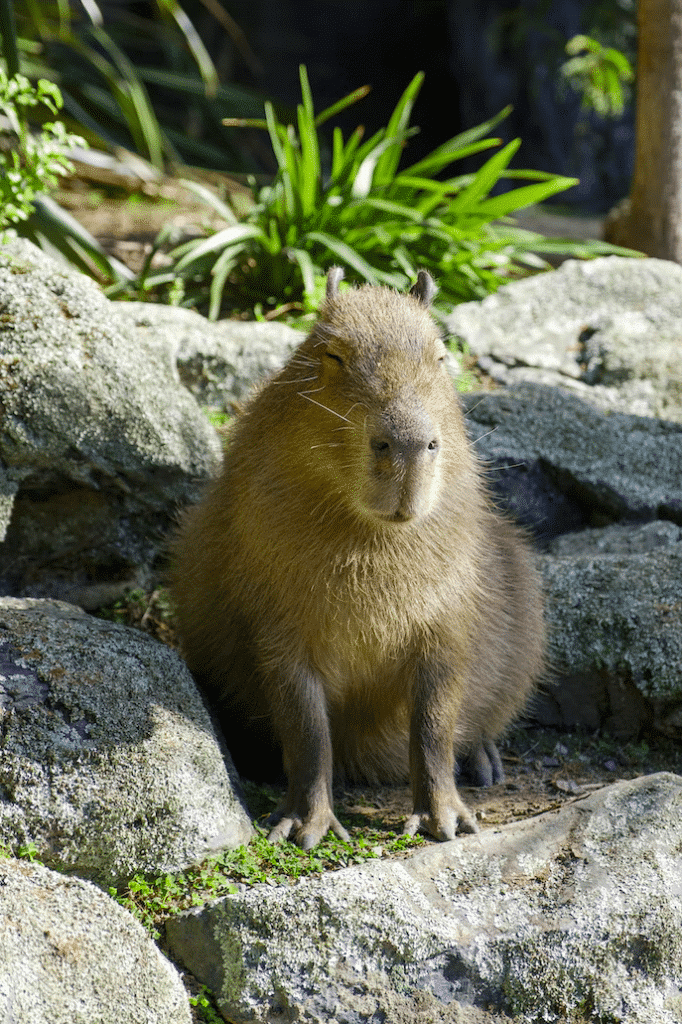
Capybaras are not just cute and social animals, they can also make excellent therapy animals. Here are some points to consider if you’re thinking about using capybaras as therapy animals:
- Calming presence
Capybaras have a very calming presence and can help to reduce anxiety and stress in humans. They are very docile and social animals, and their relaxed demeanor can be very soothing for people.
- Non-threatening
Capybaras are non-threatening animals, which makes them ideal for use in therapy settings. They are not aggressive and are unlikely to bite or harm humans, even if they feel threatened.
- Unique qualities
Capybaras are unique animals, which can make them very interesting to work with in therapy settings. Their social nature, grooming behavior, and adaptability to different environments can provide a lot of opportunities for creative and engaging therapy activities.
- Bonding opportunities
Capybaras have a strong bonding instinct and can form close relationships with humans. This can be very beneficial in therapy settings, as it can help to build trust and rapport between the capybara and the human.
Why Do People Use Capybaras as Therapy Animals?

Capybaras are also used as therapy animals because of their unique physical characteristics. For example, capybaras have a very low body fat percentage and high metabolism, which means that they do not have a strong odor.
This can be a big advantage in therapy settings where strong smells can be distracting or overwhelming for some people.
Another physical characteristic that makes capybaras ideal therapy animals is their size. Capybaras are the largest rodents in the world, but they are still relatively small compared to many other animals used in therapy settings, such as horses or dogs. This makes them easier to handle and less intimidating for some people.
In addition to their physical characteristics, capybaras also have unique behavioral characteristics that make them well-suited for use in therapy. For example, capybaras are very social animals and are often found living in large groups.
This social behavior can be very beneficial in therapy settings, as it can help to create a sense of community and belonging for people in therapy.
Capybaras are also known for their grooming behavior, which involves using their front teeth to groom themselves and each other. This grooming behavior not only helps keep their fur clean, but it also helps to maintain their social bonds.
Grooming sessions can be used in therapy settings to encourage socialization and bonding between the capybara and the human.
Capybaras are also very intelligent animals and are capable of learning a variety of tasks and behaviors. This intelligence can be used in therapy settings to teach new skills and improve cognitive function.
For example, capybaras can be trained to respond to certain commands, such as “come” or “stay,” or to perform simple tricks, such as standing on their hind legs or rolling over.
Top 10 Tips for Choosing a Capybara as a Pet

Are you considering a capybara as your next pet? These adorable creatures have captured the hearts of many with their cute faces and docile personalities.
However, owning a capybara is a big responsibility and requires careful consideration.
To ensure that you’re making an informed decision, we’ve compiled a list of the top 10 tips for choosing a capybara as a pet. Whether you’re a seasoned pet owner or a first-timer, these tips will help you provide the best possible care for your furry friend.
So, without further ado, let’s dive in!
Consider the size of your living space
Capybaras are large animals that require plenty of space to roam and play. Make sure you have a backyard or a large indoor area that can accommodate your pet’s needs.
Check local laws and regulations
Capybaras may not be legal to own in certain areas, so be sure to check your local laws and regulations before bringing one home.
Research reputable breeders
Look for breeders with a good reputation and experience in raising capybaras. Avoid buying from backyard breeders or pet stores.
Understand the cost of ownership
Capybaras can be expensive to own, with costs including food, veterinary care, and housing. Make sure you can afford the ongoing expenses of owning a capybara.
Prepare an appropriate living space
Capybaras need access to water for swimming and plenty of space to run and play. Consider building a large enclosure with a pool or pond.
Consider the temperament of the animal
Capybaras are social animals and require interaction with their human caregivers and other capybaras. Make sure you have the time and resources to provide your pet with the attention it needs.
Be prepared for potential health issues
Capybaras can be prone to certain health issues, including dental problems and parasites. Make sure you have a veterinarian who is experienced in treating capybaras.
Provide appropriate diet and nutrition
Capybaras require a specialized diet that includes plenty of hay and fresh vegetables. Make sure you have access to the appropriate foods for your pet.
Understand the lifespan of a capybara
Capybaras can live up to 8-10 years in captivity, so be prepared for a long-term commitment when bringing one into your home.
Educate yourself on capybara behavior
Capybaras have unique behaviors and communication methods, and it’s important to understand their body language and vocalizations to ensure a happy and healthy relationship with your pet.
Having mentioned Nutrition, What Do Capybaras Eat?

Capybaras are herbivorous animals, which means they only consume plant-based food. In their natural habitat, they have access to a variety of vegetation, including grasses, aquatic plants, fruits, and vegetables.
If you plan on owning a capybara as a pet, it’s important to ensure that their diet meets their nutritional needs. Their diet should be high in fiber, low in fat, and provide adequate amounts of protein and vitamins. Here are some common foods that capybaras eat:
- Hay
Hay is an essential part of a capybara’s diet, as it provides a source of fiber that aids in digestion. Timothy hay or orchard grass hay are good options.
- Grasses
Fresh grass is a staple in a capybara’s diet. They enjoy grazing on different types of grass, including Bermuda grass, fescue, and ryegrass.
- Vegetables
Vegetables are a great source of vitamins and minerals for capybaras. Some good options include lettuce, carrots, sweet potatoes, and green beans.
- Fruits
Capybaras enjoy fruits as a treat, but they should be fed in moderation due to their high sugar content. Some good options include apples, bananas, and berries.
- Pellets
Commercial pellets specifically formulated for capybaras can be a convenient way to provide them with the necessary nutrients.
PS: It’s important to avoid feeding capybaras any processed or sugary foods, as these can lead to health issues such as obesity and dental problems. Additionally, it’s essential to provide them with fresh water at all times, as they require a lot of water to stay hydrated.
What are Space and Resources Required to Care for A Capybara

Space is a crucial factor to consider before bringing home a capybara. As mentioned earlier, capybaras are large animals and need a lot of space to move around and live comfortably. Here are some important points to keep in mind when considering the space requirements for a pet capybara:
Indoor Space
While it’s important for capybaras to have outdoor access, they also need ample indoor space. A room or enclosure dedicated to your capybara should be at least 8 feet by 8 feet, with a minimum ceiling height of 4 feet.
This will give your pet enough space to move around, play, and sleep comfortably. The enclosure should be well-ventilated and have a temperature between 65-85°F.
Outdoor Space
Capybaras need plenty of outdoor space to roam and graze. An outdoor enclosure or pen should have at least 100 square feet of space per capybara, with a fence at least 4 feet high to prevent them from escaping.
The enclosure should have access to water and shelter from the sun and rain. It’s important to note that capybaras are excellent swimmers and enjoy spending time in water, so a pool or pond is a great addition to their outdoor space.
Fencing
Capybaras are strong animals and can easily break through weak fencing. The enclosure or pen should have a sturdy fence made of heavy-duty wire or wood. Make sure the fence is secure and has no gaps or holes where your pet can escape.
Interaction with other animals
If you have other pets at home, it’s important to ensure they can coexist safely with a capybara. Capybaras are social animals and can get along with other animals if they are introduced properly.
However, it’s important to supervise interactions and separate animals if there are any signs of aggression or stress.
Wrapping Up with Capybaras
Choosing a capybara as a companion can be a rewarding and fulfilling experience, but it’s important to do your research and make an informed decision.
By considering the points discussed in this article, such as finding a reputable breeder or rescue center, assessing your suitability as a capybara owner, and providing proper care and nutrition, you can ensure that you and your capybara have a happy and healthy relationship.
Remember, a capybara is not just a pet, but a long-term commitment and a beloved member of the family.
Thanks for following along with us! Next up 10 Brown Animals.
- Bald Eagle Family Expand Their Nest In California - April 24, 2024
- Firefighter Saves Abandoned Kittens Found Cuddling In Hoses - April 24, 2024
- Dolphins Get High Playing Catch With A Pufferfish - April 24, 2024

